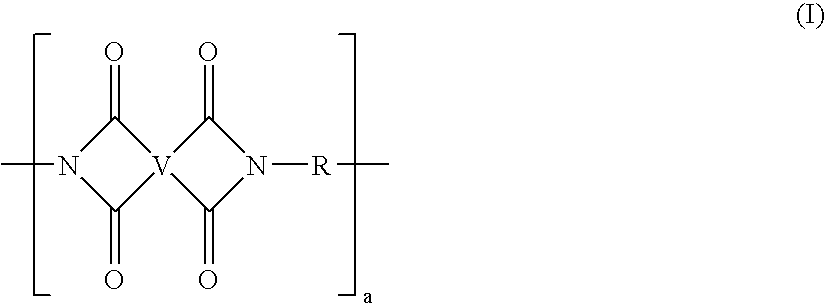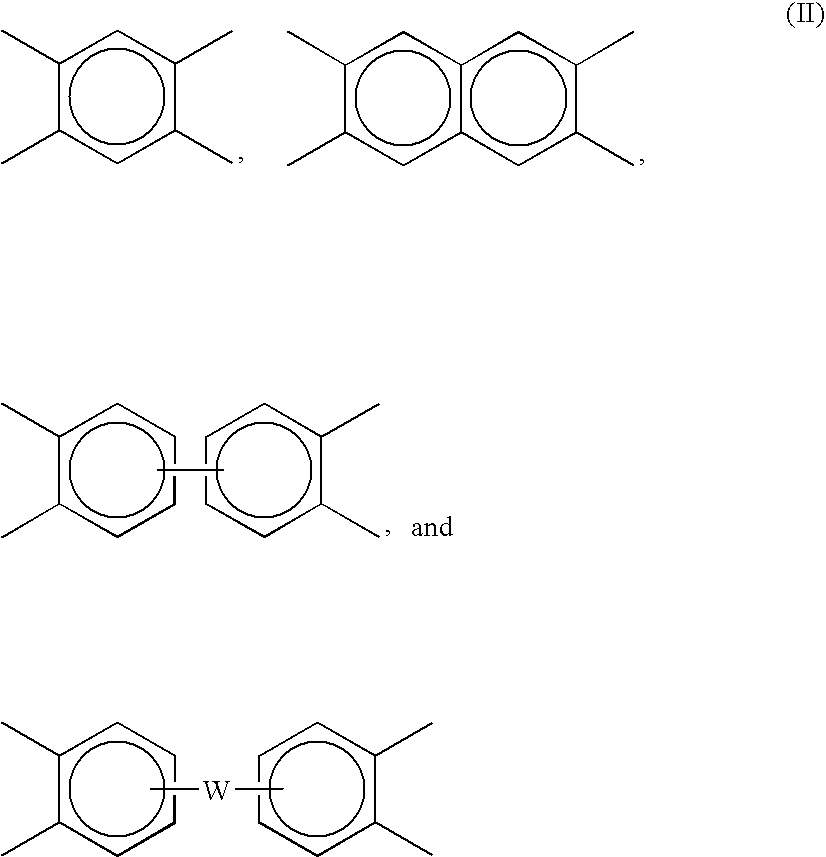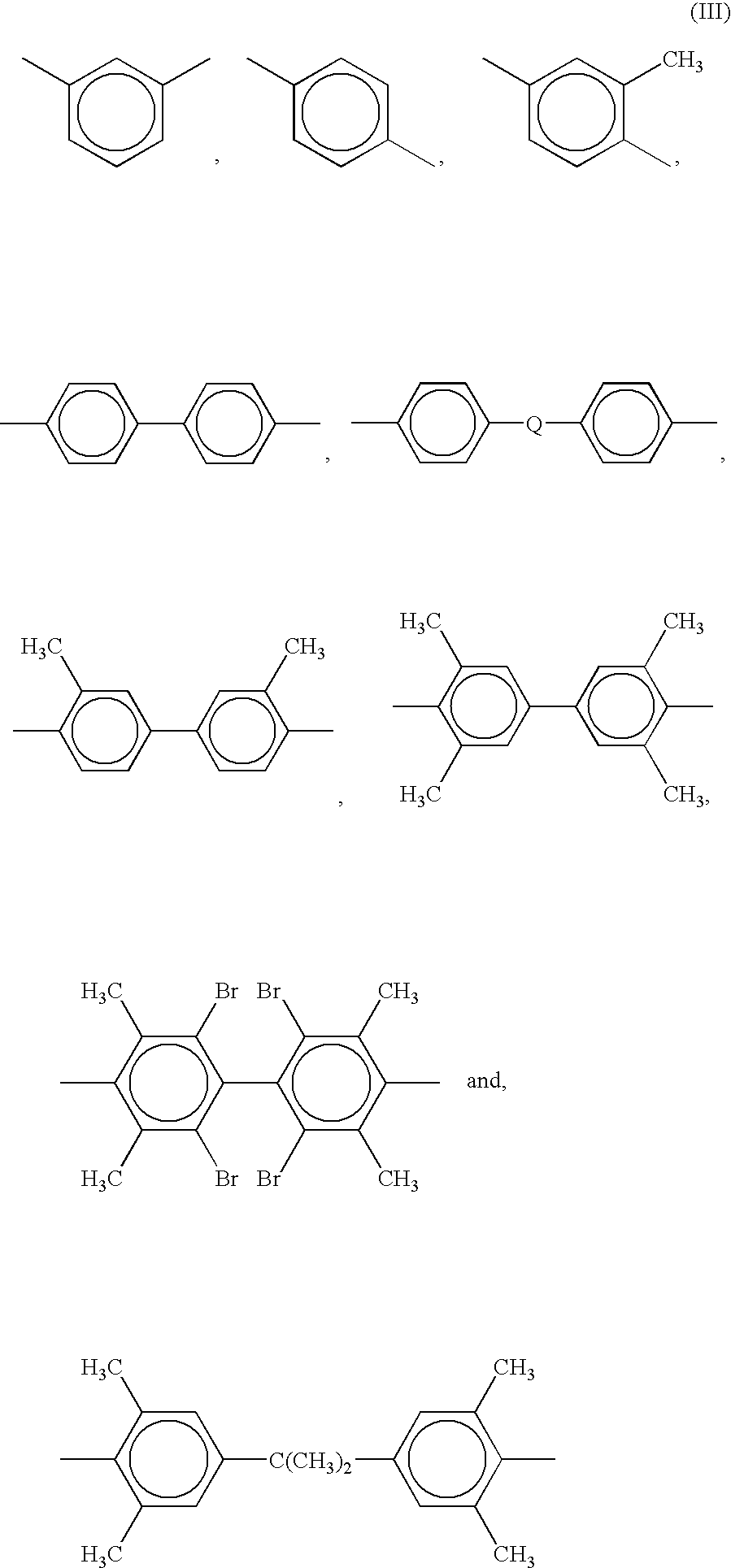Polyimide sulfones, method and articles made therefrom
a technology of polyimide sulfone and polyimide sulfone, which is applied in the field of polyimide sulfone, methods and articles made therefrom, can solve the problems of low residual volatile species, unfit for use of articles made by a melt process, and generation of parts with similar defects, etc., and achieve low residual volatile species levels, good heat resistance, and low reactive group levels
- Summary
- Abstract
- Description
- Claims
- Application Information
AI Technical Summary
Benefits of technology
Problems solved by technology
Method used
Image
Examples
example 1
Synthesis of polyetherimide sulfone: Into a reaction vessel was charged 490 kg bisphenol A dianhydride (BPADA; approximate composition: 97.6 mole % BPADA, 2.4 mole % mono N-methyl imide of BPADA), 245 kg of diaminodiphenyl sulfone (DDS), 11.0 kg phthalic anhydride (PA) with 1287 liters of o-dichlorobenzene (ODCB) and 360 grams (g) of a sodium phenyl phosphinate catalyst The reaction mixture was heated at 150-180° C. with removal of water. The product was analyzed for residual amine or anhydride end groups. Additional DDS or BPADA was added to keep the total amine and anhydride end group concentration below 20 meq / kg resin. The reaction was allowed to proceed for an additional 15 minutes and end group concentration was again measured. Additional stoichiometry corrections may be made as needed. The reaction mixture was moved to a hold tank. The tank was kept at 170° C. and fed into a solvent removal system. Solvent was removed using two wiped-film evaporators in series to reduce ODCB...
example 2
Synthesis of polyetherimide sulfone: Into a reaction vessel was charged 490 kg BPADA (approximate composition, 97.6 mole % BPADA; and 2.4 mole % mono N-methyl imide of BPADA), 245 kg of diaminodiphenyl sulfone (DDS) and 11.0 kg phthalic anhydride (PA) with 1287 liters of o-dichlorobenzene. The reaction mixture was heated at 150-180° C. until water removal was complete. The product was checked for residual amine or anhydride end groups. Additional DDS or BPADA was added to keep the total amine and anhydride end group concentration below 20 meq / kg resin. The reaction was allowed to proceed for an additional 15 minutes and end group concentration was again verified. Additional stoichiometry corrections may be made as needed. The reaction mixture was moved to a hold tank. The tank was kept at 170° C. and fed into a solvent removal system. Solvent was removed using one wiped film evaporator in series with a non-intermeshing, devolatilizing twin screw extruder. ODCB was reduced to less t...
example 3
Synthesis of stabilized polyetherimide sulfone: Into a reaction vessel was charged 490 kg BPADA (approximate composition, 97.6 mole % BPADA, and 2.4 mole % mono N-methyl imide of BPADA), 245 kg of diaminodiphenyl sulfone (DDS) and 11.0 kg phthalic anhydride (PA) with 1287 liters of o-dichlorobenzene. The reaction mixture was heated to 150-180° C. until water removal was complete. The product was checked for residual amine or anhydride end groups. Additional DDS or BPADA was added to keep the total amine and anhydride end group concentration below 20 meq / kg. The reaction was allowed to proceed for an additional 15 minutes and end group concentration was again measured. Additional stoichiometry corrections may be made as needed. Once the imidization was essentially complete and no further water was evolved, 1.46 kg of an aryl phosphonite, PEPQ from Clairant Co., was added. The reaction mixture was moved to a hold tank. The tank was kept at 170° C. and fed into a solvent removal syste...
PUM
| Property | Measurement | Unit |
|---|---|---|
| Temperature | aaaaa | aaaaa |
| Temperature | aaaaa | aaaaa |
| Fraction | aaaaa | aaaaa |
Abstract
Description
Claims
Application Information
 Login to View More
Login to View More - Generate Ideas
- Intellectual Property
- Life Sciences
- Materials
- Tech Scout
- Unparalleled Data Quality
- Higher Quality Content
- 60% Fewer Hallucinations
Browse by: Latest US Patents, China's latest patents, Technical Efficacy Thesaurus, Application Domain, Technology Topic, Popular Technical Reports.
© 2025 PatSnap. All rights reserved.Legal|Privacy policy|Modern Slavery Act Transparency Statement|Sitemap|About US| Contact US: help@patsnap.com



